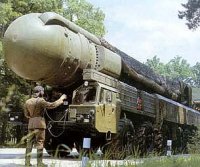Renewal of arms control
The most serious consequence of the collapse of détente and the failure of the SALT II Treaty (judged by Reagan as “seriously flawed”) appeared to be an acceleration of the arms race between the superpowers. Liberal critics feared that Reagan would unleash a new arms race; his supporters asserted that the Soviets had never stopped racing even during the era of SALT. Reagan waffled on arms policy, however, because of stiff domestic and European opposition to the abandonment of arms control. Programs to upgrade the three elements of strategic deterrence were approved only after being cut back, yet they drew complaints from the Soviet Union that the highly accurate MX missile, the new Poseidon nuclear submarines, and air-launched cruise missiles for the B-52 force were first-strike weapons. A serious NATO worry stemmed from Soviet deployment of the new SS-20 theatre ballistic missile in Europe. In 1979 the Carter administration had acceded to the request by NATO governments that the United States introduce 572 Pershing II and cruise missiles into Europe to balance the 900 SS-20s. The European antinuclear movement, however, now officially patronized by the British Labour Party, the Greens in West Germany, and Dutch and Belgian social democrats, forced Reagan to link Pershing deployment with intermediate nuclear forces (INF) talks with the U.S.S.R. Reagan tried to seize the moral high ground with his “zero-option” proposal for complete elimination of all such missiles from Europe and a call for new Strategic Arms Reduction Talks (START) to negotiate real reductions in the superpower arsenals. The Soviets, however, refused to scrap any of their long-range missiles or to trade existing SS-20s for Pershings yet to be deployed.
In March 1983, Reagan announced a major new research program to develop antiballistic missile defenses based in outer space. This Strategic Defense Initiative (SDI, dubbed “Star Wars” by opponents) was inspired by the emergence of new laser and particle-beam technology that seemed to have the potential to devise an accurate, instantaneous, and nonnuclear means of shooting down long-range missiles in their boost phase, before their multiple reentry vehicles had a chance to separate. The President thus challenged his country to exploit its technological edge to counter the threat of Soviet offensive missiles and perhaps liberate the world from fear of a nuclear holocaust. Scientific and political critics ridiculed SDI as naive (because it would not work or could be easily countered), expensive beyond reckoning, counterproductive (because it implied repudiation of the 1972 ABM Treaty), and dangerous (because the Soviets might stage a preemptive attack to prevent its deployment). The alarmed Soviets, however, weakened the case of American critics by launching their own propaganda campaign against SDI, implying that they took seriously its prospects for success. Evidence also mounted that the U.S.S.R. had been engaged in similar research since the mid-1970s. A $26,000,000,000, five-year American program was approved, although Congress limited future funding and arms-control advocates pressured the President to use SDI as a bargaining chip in the START talks. The Soviets broke off the INF and START talks at the end of 1983 but resumed talks two years later, apparently with hopes of stalling SDI research.
Самым тяжёлым последствием крушения "разрядки" междунардной напряжённости был отказ "сверхдержав" от Договора но ограничению стратегических вооружений (ОСВ-I и ОСВ-II) и возобновление гонки ядерных вооружений.
Рейган тем не менее действовал в этом направлении осторожно, учитывая давление со стороны оппозиции - противников гонки вооружений у себя дома и в Европе. Кроме того, на Западе, прежде всего, в Европе опасались РСМД (советских ракет среднего радиуса действия), особо SS-20-ракетного комплекса "Пионер". Ещё при Картере, в 1979 г., США, отреагировав на просьбу европейцев, ввезли на европейский континент 572 Першинга-2, которые предназначались сбалансировать 900 советских ракет СС-20.
Европейское антиядерное движение, включая участие в этом процессе Лейбористской партии Англии, движения «зелёных» в ФРГ, позицию голландских и бельгийских социал - демократов, склонили администрацию Рейгана включить вопрос о Першингах (американские ракеты на европейском континенте) в переговоры с СССР. При этом Рейган стремился перехватить инициативу в ходе переговоров; он преддложив «нулевой вариант» — полный вывод ракет из Европы, что должно было составить основу нового договора по ограничеению стратегических вооружений.
СССР эту идею не принял (вспомните "плана Рапацкого" о создании "безъядерных зон во времена Хрущёва).
В марте 1983 г. Рейган выступил с идеей создания СОИ— стратегической оборонной инициативы, названной его оппонентами «звёздными войнами».
Ядерщики назвали эту программу наивной. Более существенно, СОИ наносила удар по Договору ПРО 1972 г. Это могло спровоцировать Советский Союз на превентивный ядерный удар, чтобы не допустить СОИ. Сторонники СОИ в ответ критикам указывали на то, что СССР разрабатывало подобную программу с середины 1970-х гг.
26 млрд. программа СОИ, рассчитанная на 5 - летний срок, была одобрена Конгрессом США, хотя и противников СОИ среди американских законодателей было не мало. Их убедил аргумент Рейгана, что СОИ будет использоана как козырь на переговорах с советской стороной по ограничению и сокращению ядерных вооружений в целом.
СССР отказался включить вопрос о создании СОИ в повестку дня переговоров по ядерному оружию и к концу 1983 г. они были свёрнуты. Переговоры возобновились только два года спустя по инициативе советской стороны. СССР явно намеревался остановить реализацию программы СОИ.
хххххххххххххххххххххххх
 |
 |
 |
|
|
|
На эмблеме Форума изображен “аттрактор Лоренца” − фигура, воплощающая вариантность движения потоков частиц в неравновесных системах.
Эмблема зарегистрирована как товарный знак © Научно-образовательный форум по международным отношениям, 2002 Москва, Газетный пер, д. 9, стр. 7, офис 16 Адрес для корреспонденции: 101000 Москва, Почтамт, а/я 81 Тел.: (095) 790-73-94, тел./факс: (095) 202-39-34 E-mail: info@obraforum.ru |
||
